
were observed at Cape Wankarem on the 6th of August,
1881; hut the representative of this species in the rest of
Siberia, Japan, China, the Moluccas and Australia, is the
smaller and quite distinet Numenius minor.
Reinhardt says that two specimens of the Eskimo Curlew,
believed to be of Greenland origin, have been received at
Copenhagen; and undoubted Greenland examples were obtained
in August 1881 (Vid. Medd. 1881, p. 185). In
Labrador the species is found in vast numbers in :August,
feeding upon the crowberry (.Empetrunv nigrum), which ^oes
by the name of the ‘ Curlew-berry ’ among the fishermen.
It also visits Newfoundland, but comparatively few birds
appear to remain long in the--New England "States, or to
the north of the Southern States^ and Texas where seme
winter, whilst others continue their course to Mexico, the
Bermudas, Central America, and South America do^u'tJthe
Rio de la Plata. On the spring passage it migrates through
the Missouri region in flocks of from fifty to several hundreds
in April, sometimes before the snow h;as disappeared, but
it is not known to visit-i^h^T western side of the Rocky
Mountains.
The nest of the Eskimo Curlew is said by Dr. Elliott
Coues to be generally in an open plain, and is a. mere
depression in the ground, lined with a few dried leaves' or
grasses, in which the complement of four eggs is deposited
by the middle of Ju n e ., Thefp are of an oltye-drab Jaipur,
boldly blotched with different shades of brown, and ^underlying
shell-marks of grey: in measurement- they* average
2 by 1*45 in. An example, obtained by MacParlan,^-is
figured by Professor .Newton^(P,5|,S:‘ 1870, p. 56, pi; if.
fig.i). M In autumn this^ species, as already stated, feeds ;Jreely
on the crowberry, with the purple juice of which the lp^er
parts are frequently- much stained; it is also very partial
to a species of snail that -adheres 4,ix, the rocks; ^procure
which it frequents the land-washes at low tide. ^IJnder this
diet the birds become excessively, fat, and -are delicious
eating. The note is an often-repeated soft,- mellow whistle,
ESKIMO CURLEW. 515
easily imitated by gunners, but owing to the open order of
the flocks 'comparatively few are killed at a shot; the flight
is firm, direct, and very swift. The pertinacity with which
these birds cling to certain feeding-grounds, even when
much molested, is- remarkable, and Dr. Elliott Coues has
seen flocks hovering distractedly over a party- of gunners
stationed, on. a favourite mud-flat where snails abounded,
regardless of the numbers that fell at every moment (B. of
North-West, p. 5 !|§ ^ f
' The bird killed in Kincardineshire is thus described in
‘ The Naturalist,’ 1855 (p. 265) :—The bill is brownish-
black, the basal portion-of the lower mandible flesh-coloured;
irides dark brown; sides of the head yellowish-brown, with
brown streaks ; upper part Q.hthe head brownish-bl^k, edged
with reddish-brown, neck considerably lighter,, edged with
dull white; upper parts:blackish-brown, with light,edges;
primary quills dusky-brown, the shafts of the first four white,
fhe others becoming darker, ..passing/into pale brown ;
.^secondaries lighter; rump dark brown, with light edges;
-rapper tail-coverts barred with dark and light shades ; tail,
J ll twelve feathers; ash-grey, with dark brdwifhars, edged
and tipped with brownish-white; throat, , and a streak over
,.the eye, nearly white;‘ /foreneek light brown, with small
longitudinal Hyer-brown markings; under wingrcoverts chest-
-m#, with *ir«Ea^|ir.,brown markings; and ab,domen
Kgllowish-grey, tinged with brown ; tarsi and feet dark green.
The adult in- breedihg-plumage is characterized by- a more
rufous'tint/ j
P jh e ” whole length is about fourteen inches ; the. Jp ^ tw o
finches three lines;- wing, from““ anterior bend, eight inches
nine lines; 'tafsus one ipeh’ ten lines^ middle toe almost
^dhe inch.
The representationhere- given taken, on a reduced
scale, from Mr. Swainson’s figuii§ in the <:Pauna Boreali-
Salfmericana,.’ -